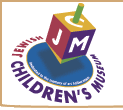|
Grand Opening
CONTACT:
Yifat Russ
718-907-8803
WORLD’S FIRST JEWISH CHILDREN’S MUSEUM MARKS GRAND OPENING ON FIRST NIGHT OF CHANUKAH
Hilary Clinton, Rudy Guiliani, Mayor Michael Bloomberg, and Governor George Pataki expected for dedication and ribbon-cutting of 50,000 sq.- foot, $30 million facility committed to promoting tolerance by introducing Jewish life to children of all backgrounds
BROOKLYN, NY; November 29, 2004 – After a decade of careful planning, the Jewish Children’s Museum will have its grand opening on December 7th 2004. Numerous dignitaries, including Senator Hilary Rodham Clinton and former Mayor Rudy Giuliani, Mayor Michael Bloomberg, and Governor George Pataki, along with children from many backgrounds and cultures, are expected to attend the dedication, ribbon-cutting, and giant menorah-lighting ceremony, which will begin at 4:00 p.m. Immediately following the ceremony, the children and dignitaries will be given a tour of the exhibits, which will be open to the media.
The only museum of its kind in the world, the 7-story Jewish Children’s Museum has been designed to introduce Jewish culture, history, and traditions to children of all backgrounds. State-of-the-art technology and a hands-on approach to learning are used in more than 80 interactive exhibits to engage, entertain and educate elementary school age children and their parents and teachers. By inspiring visitors to gain an increased interest in and positive perspective on Jewish life, the museum is helping to shatter stereotypes and misconceptions and foster tolerance and understanding among all people. It is this mission that makes the museum an extremely fitting memorial to Ari Halberstam, the Brooklyn-born and raised teenager who was killed by a Lebanese terrorist on the Brooklyn Bridge in 1994.
Located in the heart of Brooklyn on the corner of Eastern Parkway and Kingston Avenue in Crown Heights—an ethnically diverse neighborhood that in the past has seen its share of racial tension and conflict—the museum takes its outreach role seriously. Tours and materials have been crafted to appeal to a wide range of children—especially groups of students from the New York City public schools and out-of-town visitors. In addition, the museum’s exhibits explore the diversity that exists within the world’s Jewish community itself. Many visitors may be surprised to discover, for example, that there are Jews of color.
According to Rabbi Yerachmiel Benjaminson, the museum’s executive director, “The Jewish Children’s Museum is the best kind of hands-on education—a place where kids will have so much fun that they don’t even realize that they’re learning. It is our hope that if we can correct some of the misunderstandings that people—including Jews—have about other Jews and Jewish life, we can play an important role in shaping a more peaceful, tolerant society. This, then, would be a truly fitting memorial to Ari Halberstam who was murdered simply because of his religious and ethnic background.”
The museum itself is a marvel of multi-media technology, enabling children to use all their senses as they explore and discover. Among the highlights of this extraordinary venue are include:
• A working television newsroom where children can record segments on the story of Chanukah.
• A giant Sabbath dinner table to walk on and explore that includes a challah to climb in and matzoh ball shaped computers that print Jewish recipes from around the world.
• A scaled down kosher supermarket, complete with working checkout scanners and kitchen with talking refrigerator where children can role play as they explore Jewish dietary laws.
• A game-show studio where visitors can play games based on Jeopardy and Wheel of Fortune.
• A six-hole outdoor miniature golf course that introduces Jewish lifecycle events.
• Crafts workshops in which visitors can create arts-and-crafts projects to take home.
The 50,000 square foot, fully-wired facility has been designed by the award-winning architecture firm of Gwathmey Siegel & Associates, which has completed more than 300 projects, including the American Museum of the Moving Image and projects for the Guggenheim Museum, Columbia Presbyterian Hospital, and the New York Public Library. The façade features the largest known photomosaic, a 20’ x 30’ picture of a child created with more than 1400 images of children. A stunning 12-foot high Chanukah driedel graces the museum’s plaza.
A project of Tzivos Hashem, one of the world’s largest and most successful Jewish children’s organizations, the museum is the result of the collaboration of a team of educators, designers, engineers and professionals, including noted museum consultant Paul Rosenthal, who has developed text and programs for the Liberty Museum at the Statue of Liberty, the Barnum Museum and many others. As such, it is a resource and model, nationally and internationally, for interactive education on Jewish themes.
According to Emma F. Mosley and Edith Medina, the educational director and assistant director of the Salvation Army Day Care Center in Brooklyn, “We are happy to see a museum that is a hands on multi-cultural teaching/learning center. We think it’s excellent!”
Unlike other museums that shut down after hours, the Jewish Children’s Museum will also serve as a community center, offering after-school enrichment classes and special programs. The ground floor of the building, which can be accessed from a separate entrance, features a lending library, fully-equipped computer labs, and crafts workshops.
Entry to the museum is currently by advanced ticket purchase only. Reservations are now being accepted for after December 23, 2004. Tickets are $10. For details and to purchase tickets, visit www.jcm.museum/tickets.
ABOUT TZIVOS HASHEM
The Jewish Children’s Museum is a project of Tzivos Hashem. Tzivos Hashem, headquartered in Brooklyn, NY, is one of the largest Jewish Children’s organizations in the world. Since its inception in 1980 under the direction of the Lubavitcher Rebbe, Rabbi Menachem Mendel Schneerson, more than 1,000,000 children in the United States, the Former Soviet Union, and other countries have reaped the benefits of its fun, educational, religious-based, and humanitarian programs.
|





